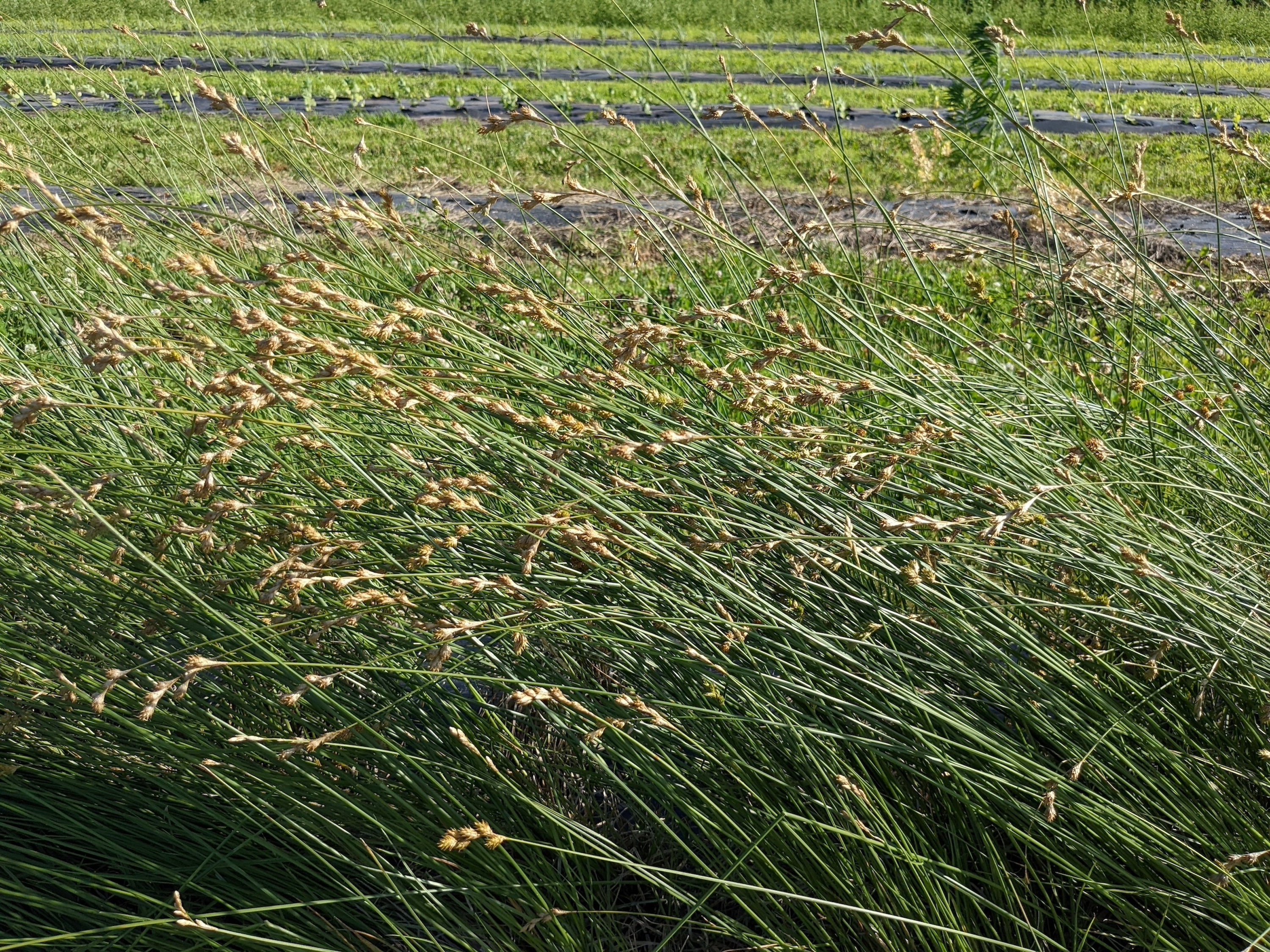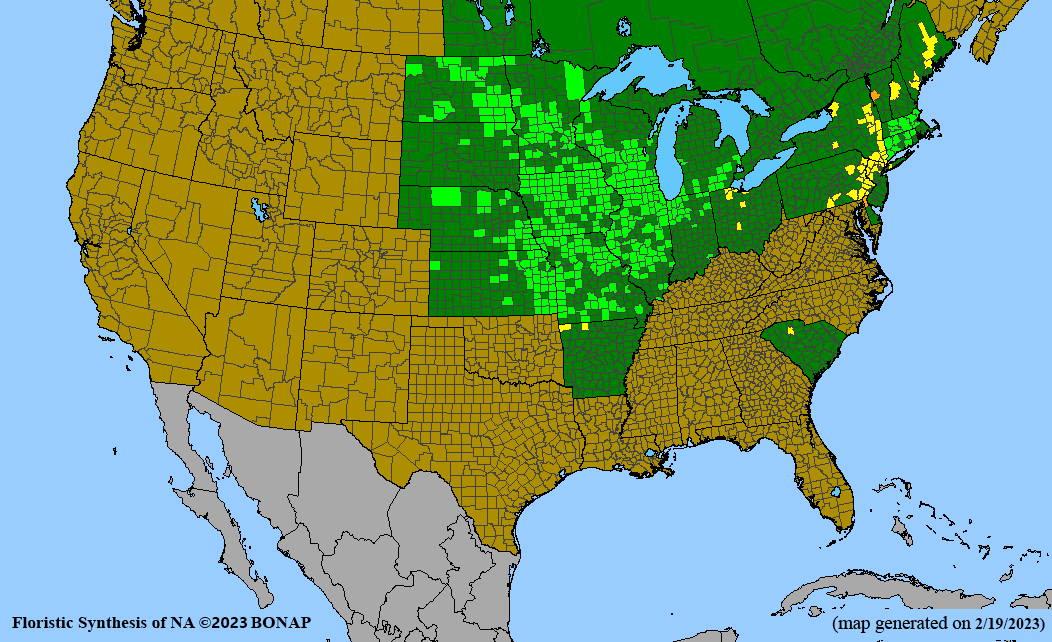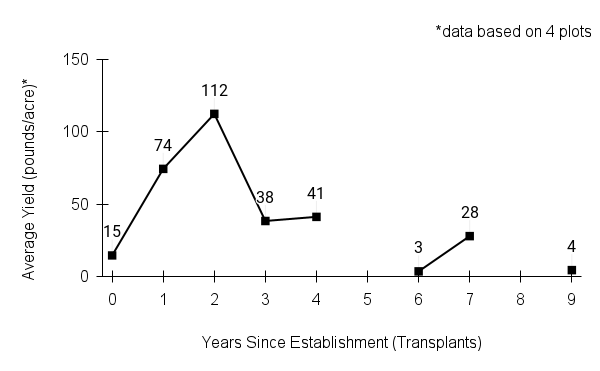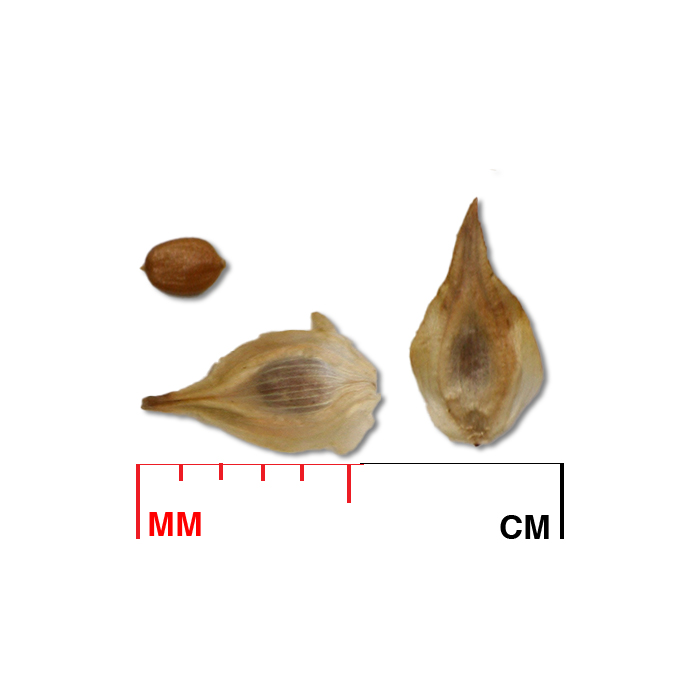Bicknell's sedge
Table of Contents
Carex bicknellii Britton
Alternate Common Names: Bicknell’s oval sedge, copper-shouldered oval sedge
Scientific Synonyms: Carex bicknellii Britton var. bicknellii, Carex brevior. (Dewey) Mack var. crawei (W. Boott) B. Boivin, Carex straminea var. crawei Boott, Carex straminea Willd. var. meadii Boott
Family: sedge family (Cyperaceae)
Functional Group: sedges and rushes
Description
- Life cycle and growth form
perennial, short black rhizomes, forms bunches
Height: 1-4 ft

- Leaves and stem
3-4 leaves per stem, alternate, three-ranked, rough margins, pale green, flat and thin
- Flower, fruit and seedhead
Flower/fruit/seedhead: Erect to arching seed heads 2-6 cm long; 3-6 oval spikes with cone-shaped bases, each 10-18 mm long, per stem.
Pollination: wind
- Seed
Seed characteristics
Seed weight:
Seeds per ounce: 17,000 seeds/oz (IA NRCS)
1000 seed weight: 1.31g (Seed Information Database)
Description: Achene broadly elliptical, brown; mature perigynium (sac-like structure around the achene) flattened, with a translucent and membranous wing, distinct, parallel veins, and coppery-brown “shoulders,” the source of one alternate common name, “copper-shouldered oval sedge.”
Typical seed test
PLS: 84% (n = 11)
Purity: 98% (n = 10)
Germination: 30% (n = 7)
Dormancy: 61% (n = 7)
(averages obtained from n tests of purchased seed lots)
- Habitat and range
Habitat: Dry to moist soil; full sun; prairies, rock outcrops, savannas, along railroads; Wetland Indicator Status is Facultative Upland (FACU) for the Midwest.
Conservation status: Global- G5, secure; Delaware- SX, presumed extirpated; Vermont- SH, possibly extirpated; Arkansas, Maine, New Hampshire, Pennsylvania, and South Carolina- S1, critically imperiled; Massachusetts- S1/S2, critically imperiled to imperiled; New Jersey and Ohio- S2, imperiled (NatureServe)

General Comments
Sedges are a large, diverse group of grass-like plants that are important components of prairies, wetlands, and woodlands across our region. In Iowa alone, there are about 120 species of sedges. Grasshoppers and the larvae of skipper butterflies, among other insects, feed on sedge foliage, and their seeds are eaten by grassland birds. They are notoriously difficult to identify to species, especially the oval sedges to which Bicknell’s sedge belongs. The development of stock seed by the Tallgrass Prairie Center in the early 2000s enabled broader access to reliably identified sedge species by native seed growers. The large, winged perigynia of Carex bicknellii, with their pearly color and translucence, make this species somewhat easier to identify than other oval sedges. This species is also one of a few oval sedges that are commonly found in upland prairie habitats. Seed production plots of Carex bicknellii in mesic to dry mesic soils do not require irrigation.
Recommendations for Seed Production
- Establishment for seed production
Direct seeding
Not recommended for this species.
Greenhouse
Seed pre-treatment: 30 days cold-moist stratification; removal of perigynia produces a similar effect as stratification on germination in this species.
Sowing: Sow in germination flats or directly into plugs (2-3 seeds per cell), covering seed lightly (light improves germination of many sedge species); maintain even moisture until germination. Daytime temperatures should be around 70-80°F (22-27°C) and allowed to drop at night to 50-60°F (10-15°C). We have had good success planting into 2.5 in deep, 73-cell plug flats that are ridged to direct root development downward and have 3/4 in bottom openings to encourage root pruning and the formation of firmly rooted plugs for transplanting.
Transplanting: Seedlings are ready to transplant to the field about 10 weeks after sowing. Pop out a few plugs to check for adequate root development that will provide sturdy plugs for planting. A week or two before transplanting, move flats outside to ‘harden off.’
- Stand management
Weeds: Plastic mulch reduces weed pressure in the first year or more. Holes in the plastic should be widened somewhat in subsequent years to allow the bunches to expand. The most significant weed issue can be the presence of other oval sedges such as Carex brevior and Carex molesta, since they are competitive and their seed is difficult to distinguish from Carex bicknellii in the field and practically impossible to clean out of harvested seed. Obtaining clean, reliably identified, certified stock seed helps to prevent this issue.
Pests: None noted.
Diseases: None noted.
- Seed production

First harvest: There may be a small amount of seed in the first season, but most plants begin flowering and producing seed in their second growing season after transplanting.
Yield: Peak harvests are in the second through fourth years after transplanting, with yields from 40-112 pounds per acre, extrapolated from harvests of four plots grown at the Tallgrass Prairie Center.
Stand life: Plants may persist for up to ten years or more, but productive stand life is about five years, after which our yields have declined.
Flowering date: June in northeast Iowa
Seed maturity: Mid-late June to early July
Seed retention: Significant shattering occurs in high winds when perigynia are mature; lodging can also occur due to heavy rains/storms, complicating combine harvest.
Harvest date range at TPC (2007-2023): June 14 - July 31
Recommended harvest method: Combine when mature; a good rule of thumb is to wait until about 10% of seed heads have begun shattering.
- Seed cleaning and storage
Cleaning process: Air-dry seed for two weeks or more after harvest. Pass material through a coarse screen (1/2 in hardware cloth) to remove larger stemmy material, if needed, then air screen. If perigynia removal is desired, pass material through a brush machine with medium bristles before air screening. (Note: perigynia removal destroys several characteristics used in identification.)
Seed storage: cool/dry (33-50° F, 30-50% RH)
Released Germplasm
Source Identified material: Natural Selections/Iowa Ecotype Zone 1 (northern IA) and Zone 2 (central IA)
- References
Boeck Crew, C.M., Myers, M.C., Sherrard, M.E., Elgersma, K.J., Houseal, G.A., & Smith D.D. (2020). Stratification and perigynia removal improve total germination and germination speed in 3 upland prairie sedge species. Native Plants Journal, 21(2), 120-131. https://doi.org/10.3368/npj.21.2.120
Chayka, Katy. (n.d.). Carex bicknellii (Bicknell’s sedge). Minnesota Wildflowers. https://www.minnesotawildflowers.info/grass-sedge-rush/bicknells-sedge
Cochrane, T. S., Elliot, K., & Lipke, C. S. (2014). Bicknell’s Sedge. In Prairie Plants of the University of Wisconsin-Madison Arboretum (3rd ed., p. 160). University of Wisconsin-Madison Arboretum.
Hilty, J. (2019). Bicknell’s sedge - Carex bicknellii. Illinois Wildflowers. https://www.illinoiswildflowers.info/grasses/plants/bicknell_sedge.htm
Houseal, G. (2010). Plasticulture for seed production of wetland (Carex) species. Native Plants Journal, 11(1), 58-64. https://doi.org/10.2979/NPJ.2010.11.1.58
Mastrogiuseppe, J., Rothrock, P. E., Dibble, A. C., & Reznicek, A. A. (2020, November 5). Carex bicknellii Britton. Flora of North America. http://floranorthamerica.org/Carex_bicknellii
Mohlenbrock, R. H. (1999). Carex bicknellii. In Illustrated Flora of Illinois - Sedges: Carex (p. 139). Southern Illinois University Press.
Murphy, M. & Spyreas, G. & Marcum, P. (2025) Carex of Illinois & Surrounding States: The Oval Sedges. University of Illinois Press
NatureServe. 2024. NatureServe Network Biodiversity Location Data accessed through NatureServe Explorer [web application]. NatureServe, Arlington, Virginia. Available https://explorer.natureserve.org/. (Accessed: February 28, 2024).
Schütz, W. & Rave, G. (1999). The effect of cold stratification and light on the seed germination of temperate sedges (Carex) from various habitats and implications for regenerative strategies. Plant Ecology 144, 215–230. https://doi.org/10.1023/A:1009892004730
USDA NRCS National Plant Data Team. (n.d.). Carex bicknellii Britton. USDA plants database. https://plants.usda.gov/home/plantProfile?symbol=CABI3
Species Guide Updated 2/5/2025



